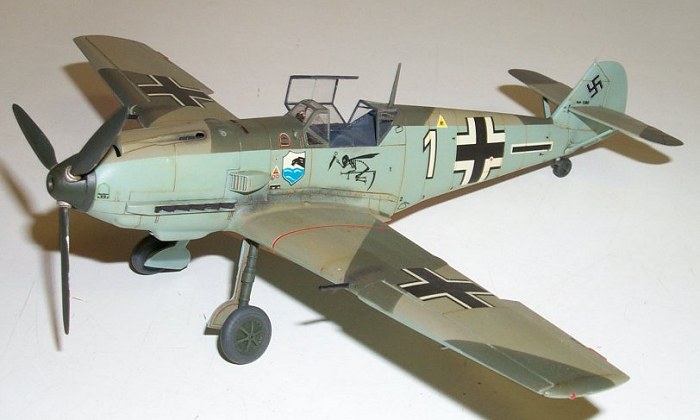
Hasegawa 1/48 Bf-109E-4/7
|
KIT # |
? |
|
PRICE: |
$? |
|
DECALS: |
Four options |
|
REVIEWER: |
Michael Johnson |
|
NOTES: |

|
HISTORY |
Messerschmitt’s Bf109 E-4/7
aircraft, until the appearance of the F model near the end of the Battle
of Britain, were the Luftwaffe’s main fighters. They were used in all
theatres of operation during WW2. While the design and configuration of
the 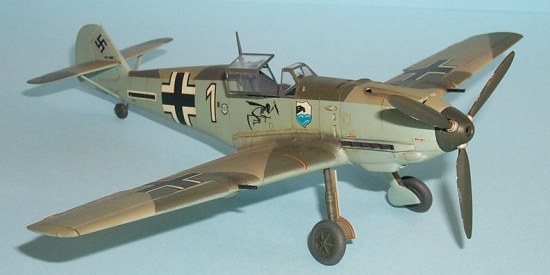 E-4 was basically the same as the E-3, it had the improved square
canopy. The E-7 version had a centreline rack mounted to the fuselage for
a 300 litre fuel tank, plus most of the E-7’s also used a pointed, bullet
shaped spinner
E-4 was basically the same as the E-3, it had the improved square
canopy. The E-7 version had a centreline rack mounted to the fuselage for
a 300 litre fuel tank, plus most of the E-7’s also used a pointed, bullet
shaped spinner
|
THE KIT |
This kit was a gift to me from an American friend, who regularly sends me a box of goodies throughout the year. The kit is of the “high tech” variety, containing an etched brass fret and featuring dropped flaps and optional position leading edge slots. I was absolutely delighted to receive this particular subject as I enjoy building Hasegawa kits. They fall together with little effort and are excellent for hassle free building. The decal sheet was large and comprehensive, allowing a modeler to build either of 4 different schemes.
|
CONSTRUCTION |
Construction starts as usual with the cockpit. The cockpit sidewalls,
seat and floor were painted RLM66. The instrument panel is a fine piece
of moulding, with loads of detail just waiting to be enhanced by careful
painting. A base coat of RLM66 was applied, once this was dry the
instrument dials were picked out in black and dry brushed in white to
bring out dial details. Super stride was then carefully placed into each
dial to simulate glass. Super stride (the Australian equivalent of
Future/Kleer) is as thin as water, which allows it to be hand brushed on
or airbrushed on with no thinning. It dries to a
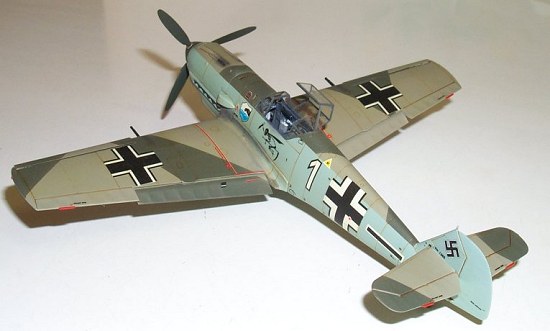 marvelous gloss finish.
Repeated applications increase the gloss. The pilot seat was tackled next
with belts picked out in light grey and buckles in silver. I then washed
the whole cockpit area in raw umber oils and dry brushed to enhance
detail. Careful painting enhanced remaining cockpit features, with
constant cross checking to my references. The cockpit was then assembled
and left aside to dry.
marvelous gloss finish.
Repeated applications increase the gloss. The pilot seat was tackled next
with belts picked out in light grey and buckles in silver. I then washed
the whole cockpit area in raw umber oils and dry brushed to enhance
detail. Careful painting enhanced remaining cockpit features, with
constant cross checking to my references. The cockpit was then assembled
and left aside to dry.
The etched brass fret consists of replacement parts for the small radiator grills and control baffles under the wings. There is also a part for the intake baffle within the air intake below the engine. These parts were carefully snipped from the fret, cleaned up and super glued into place before the various shrouds were attached to the underside of the wing. The baffle under the engine was left to after the two fuselage halves were joined so as to ensure a horizontal position.
Now comes the good part, fuselage halves were duly joined, with the assembled cockpit sandwiched between. (At this point something usually has gone wrong. My fingers were crossed!). The completed assembly was then set aside to dry.
Wings were next on the list and were assembled with no fuss at all. The leading edge slots and flaps were tacked into their respective “retracted” positions in readiness for painting. The wings fitted to the fuselage perfectly. On all sub assemblies, engraved panel lines were re-engraved where necessary. Tail planes were added and the cockpit transparencies masked and attached in readiness for painting.
|
COLORS & MARKINGS |
A tough choice had to be made when selecting a paint scheme. The kit allows 4 versions of the “Emil” to be built. The choices were as follows;
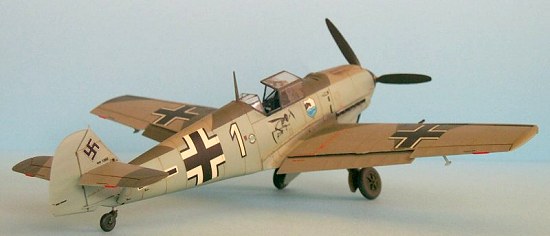 After much soul searching and gnashing of teeth I decided to build
option 3. This particular “Emil” carried a simple RLM02/71 splinter
camouflage pattern over the wings and fuselage spine, with the underside
RLM 65 carried high up the fuselage sides. There was no mottle at all,
which I thought was part of the schemes appeal. In addition to the
JagdStaffel shield on either side of the nose, the subject carried a
caped skeleton riding a scythe.
After much soul searching and gnashing of teeth I decided to build
option 3. This particular “Emil” carried a simple RLM02/71 splinter
camouflage pattern over the wings and fuselage spine, with the underside
RLM 65 carried high up the fuselage sides. There was no mottle at all,
which I thought was part of the schemes appeal. In addition to the
JagdStaffel shield on either side of the nose, the subject carried a
caped skeleton riding a scythe.
Choice of scheme made, I used paints from my excellent but dwindling Aeromaster “Warbird” acrylics supply. These sprayed perfectly as usual. Once the paints had dried I used “Super Stride” to give a gloss surface ready for the decals.
The decals looked a little thick on their backing sheet, but were excellent quality, dense and sharp. This proved to be the case when the decals were used on the model. They bedded down well and responded excellently to Aeromaster setting solution, with only the smallest amount of silvering occurring. The “Emil” was then set aside for 24 hours to allow the decals to dry.
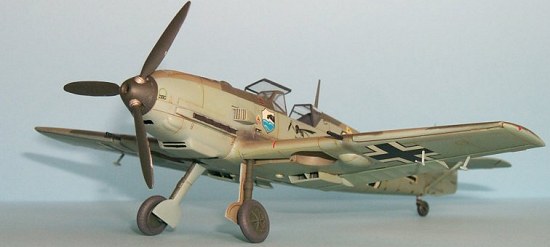 Weathering
Weathering
My favourite part of building a model kit would have to be weathering! After the decals had dried I sealed the whole plane with another coat of future (wash the decal solution and decal glue away first) and used a raw umber/burnt sienna oil wash to enhance the recessed panel lines. This looks absolutely atrocious until the excess is wiped away with a cotton bud moistened in white spirits. “The Super Stride” protects the paintwork and decals from any damage by the washing procedure. Once again the model was put aside to cure and finally sprayed with Aeromaster flat, to give a matt appearance.
|
FINAL CONSTRUCTION |
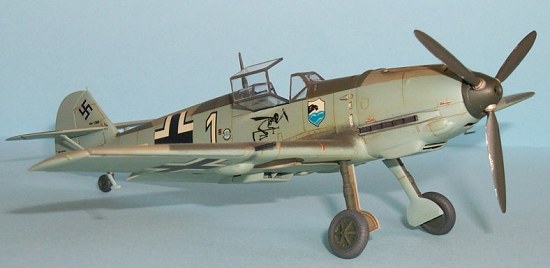 Undercarriage was the last item to be added and apart from careful
applications of powdered pastel around the engine exhaust and gun
barrels, my “Emil” was finished!! All masking was then removed and the
canopy cemented into place using Testors clear parts cement. Finally the
flaps and leading edge slots were repositioned “down”.
Undercarriage was the last item to be added and apart from careful
applications of powdered pastel around the engine exhaust and gun
barrels, my “Emil” was finished!! All masking was then removed and the
canopy cemented into place using Testors clear parts cement. Finally the
flaps and leading edge slots were repositioned “down”.
|
CONCLUSIONS |
All together, another fine Hasegawa product. No filler was used throughout the whole model kit with all the parts fitting positively. It was this, more than anything that made this kit a most enjoyable trouble free, build providing me with a break from my usual Monogram kits.
It is difficult to compare this kit with the equally excellent Tamiya offering, as I do not have the Tamiya one in my stash. But the comments were excellent around the club table, particularly from the club “109” expert. It looks like a Bf109 and that is good enough for me!
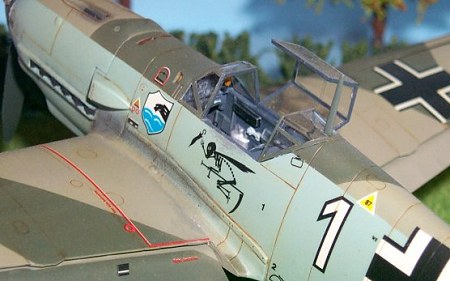
|
REFERENCES |
Me109 in action pt 1, Squadron/Signal books
August 2004
If you would like your product reviewed fairly and fairly quickly, please contact the editor or see other details in the Note to Contributors.